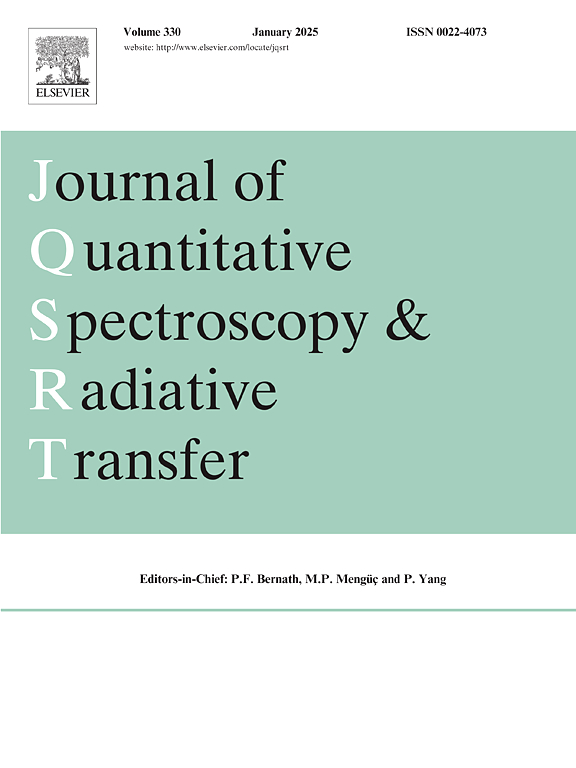Effective properties of resonant nanoparticle suspensions: Impact of the elementary volume shape and eigenmodes analysis
IF 2.3
3区 物理与天体物理
Q2 OPTICS
Journal of Quantitative Spectroscopy & Radiative Transfer
Pub Date : 2025-06-07
DOI:10.1016/j.jqsrt.2025.109529
引用次数: 0
Abstract
The study of the effective properties of random particulate materials is a storied subject, which gave rise to several effective-medium theories establishing a link between the microstructure and the macroscopic properties of inhomogeneous materials. This link is typically provided by the effective refractive index. However, effective-medium theories are defective when resonant interactions between the particles take place. Homogenization must then be performed via Maxwell’s equations from the rigorous calculation of the electromagnetic fields averaged over a statistical ensemble of realizations of the random medium in a finite domain, i.e., different configurations of the geometrical particle distribution. In even more restricted regimes originating from interparticle coupling, one observes markedly high field intensities at the surface of the particles or in localized regions of the agglomerate, casting doubts on the representativeness of the calculated mean field to extract an effective refractive index. Here we show that the value of the extracted effective refractive index may strongly depend on the shape of the ensemble’s configurations, irrespective of the statistical fluctuations of the states. This result is obtained by performing homogenization on systems of particles arranged in the shape of elliptic domains, with different eccentricities. The impact of the boundary effects on the effective refractive index is analyzed through the calculation of the quasinormal modes of the particulate systems, evidencing either strong fluctuations of the eigenfrequencies in the complex plane or Mie-type eigenmodes.
共振纳米颗粒悬浮液的有效性质:基本体积形状和本征模态分析的影响
随机颗粒材料有效性能的研究是一个富有历史意义的课题,它产生了几种有效介质理论,建立了非均匀材料微观结构与宏观性能之间的联系。这种联系通常由有效折射率提供。然而,当粒子之间发生共振相互作用时,有效介质理论是有缺陷的。然后,均匀化必须通过麦克斯韦方程来执行,该方程严格计算了在有限域中随机介质实现的统计集合上平均的电磁场,即几何粒子分布的不同配置。在由粒子间耦合产生的更严格的情况下,人们在粒子表面或团块的局部区域观察到明显的高场强,这使人们对计算的平均场的代表性产生怀疑,以提取有效折射率。在这里,我们证明了提取的有效折射率的值可能强烈地依赖于系综构型的形状,而不考虑态的统计波动。这一结果是通过对具有不同偏心率的椭圆形状的粒子系统进行均匀化而得到的。通过计算粒子系统的准正态模,分析了边界效应对有效折射率的影响,证明了在复平面上本征频率的强波动或mie型本征模。
本文章由计算机程序翻译,如有差异,请以英文原文为准。
求助全文
约1分钟内获得全文
求助全文
来源期刊
CiteScore
5.30
自引率
21.70%
发文量
273
审稿时长
58 days
期刊介绍:
Papers with the following subject areas are suitable for publication in the Journal of Quantitative Spectroscopy and Radiative Transfer:
- Theoretical and experimental aspects of the spectra of atoms, molecules, ions, and plasmas.
- Spectral lineshape studies including models and computational algorithms.
- Atmospheric spectroscopy.
- Theoretical and experimental aspects of light scattering.
- Application of light scattering in particle characterization and remote sensing.
- Application of light scattering in biological sciences and medicine.
- Radiative transfer in absorbing, emitting, and scattering media.
- Radiative transfer in stochastic media.

 求助内容:
求助内容: 应助结果提醒方式:
应助结果提醒方式:


